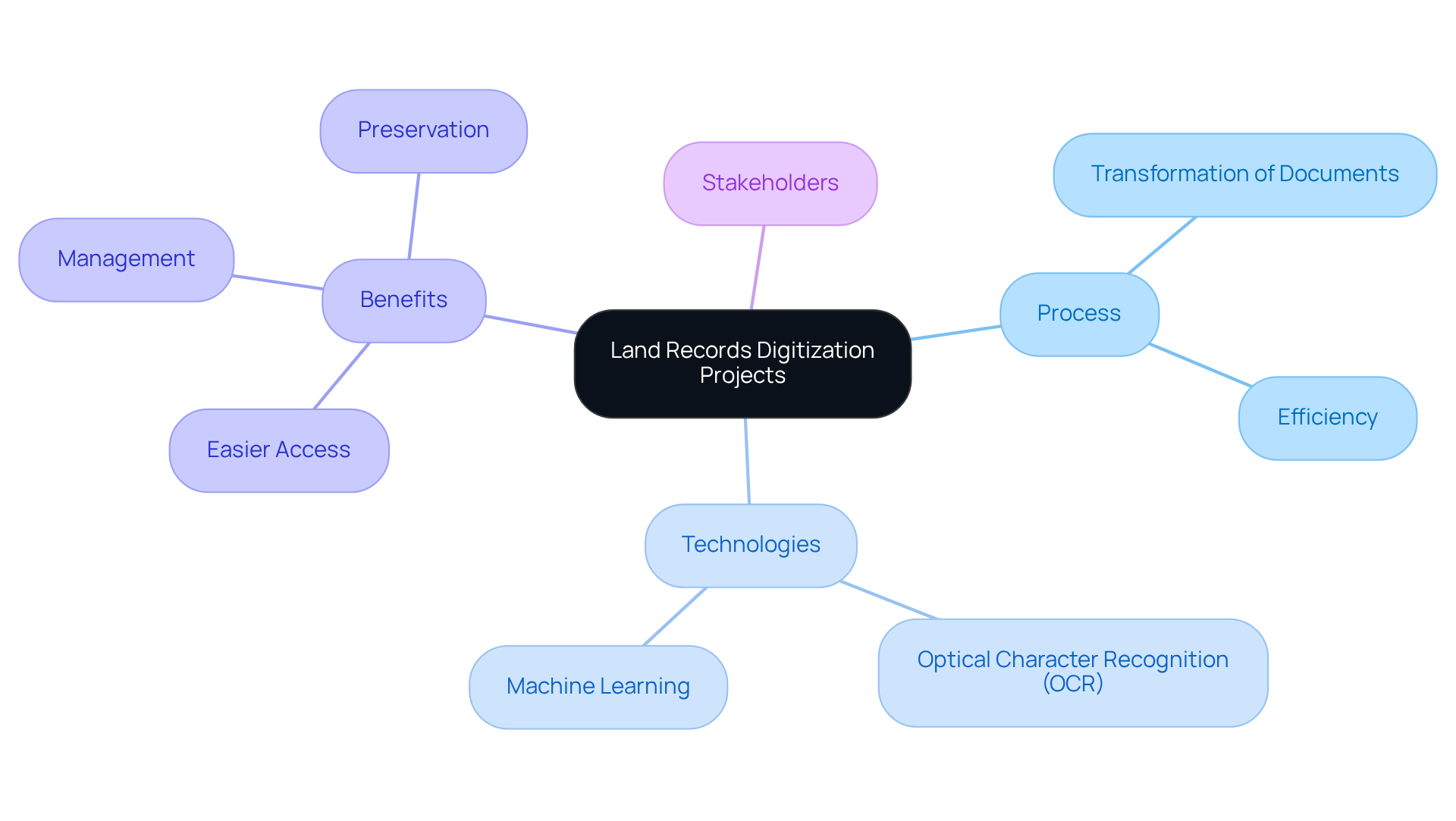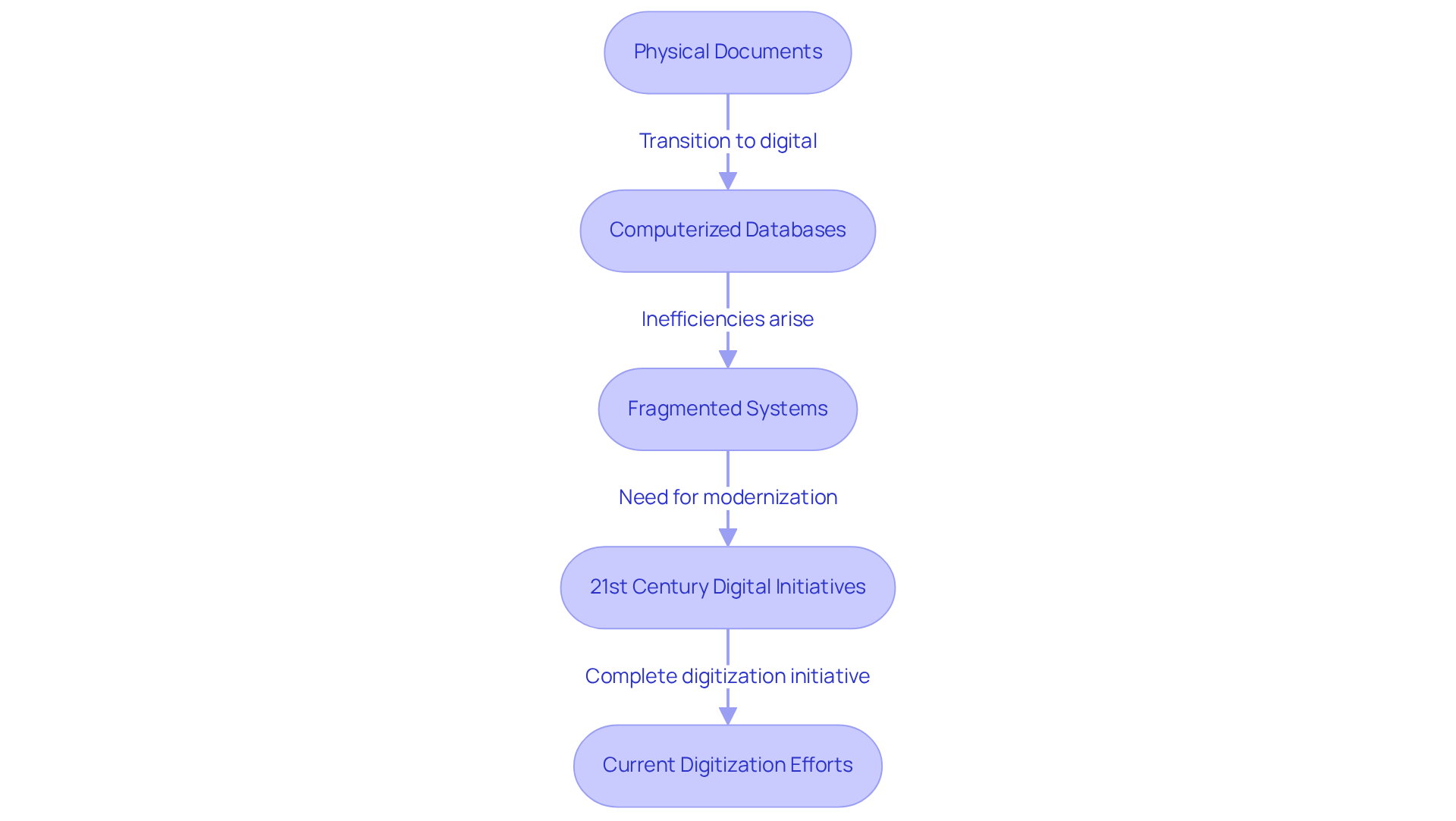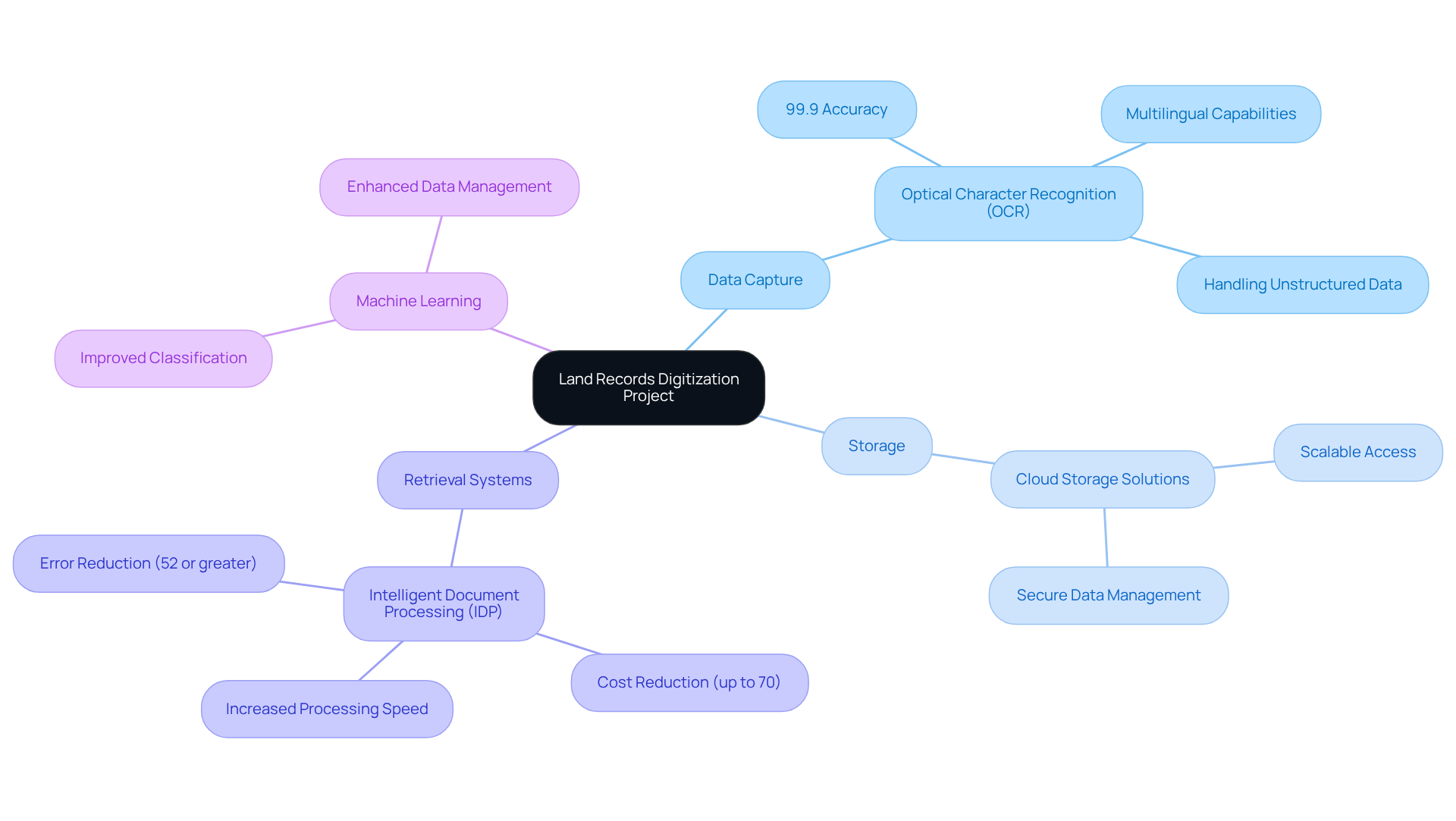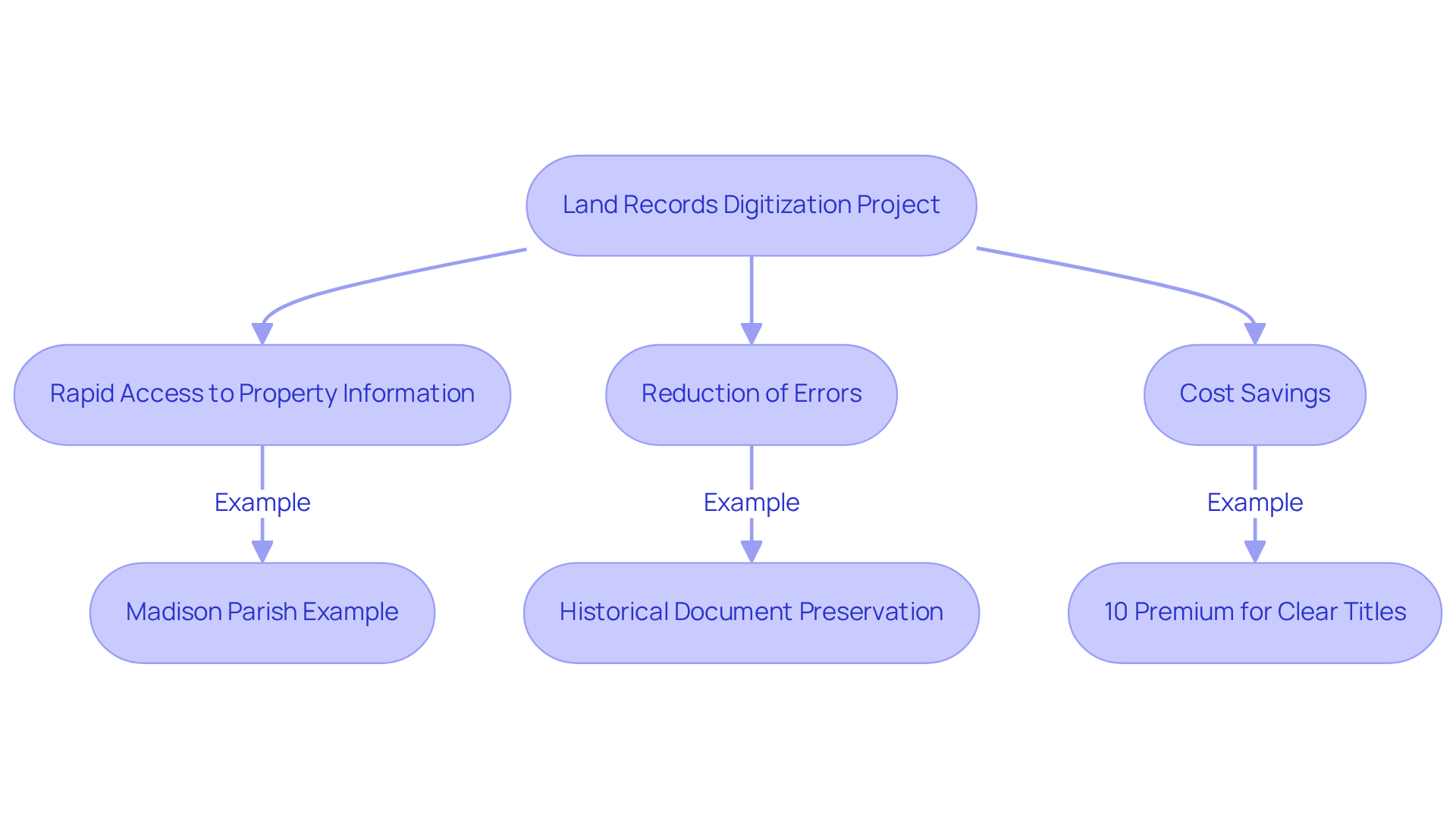Overview
A land records digitization project entails the conversion of physical property documents into digital formats, significantly enhancing access, management, and analysis of property information. This process not only improves the efficiency and reliability of real estate transactions but also preserves historical documents and mitigates disputes.
Furthermore, it leverages advanced technologies such as OCR and machine learning, ensuring high accuracy and faster retrieval of property data. Consequently, this initiative fosters economic growth and promotes better governance in land management.
Introduction
The transformation of land records from physical to digital formats is not merely a technological upgrade; it signifies a pivotal shift in the accessibility and management of property information. By exploring the intricacies of land records digitization projects, readers will discover the substantial benefits these initiatives present, including:
- Enhanced efficiency
- Reduced disputes
- Improved transparency in real estate transactions
Furthermore, as the landscape of property management evolves, one pressing question emerges: how can stakeholders effectively navigate the challenges of this digital transition to fully realize its potential?
Define Land Records Digitization Projects
Understanding what is a involves the transformation of physical documents—such as deeds, titles, and surveys—into digital formats, which is crucial. This process facilitates easier access, management, and analysis of property information. By leveraging technologies like optical character recognition (OCR) and machine learning, these initiatives significantly enhance the efficiency and precision of property management. Furthermore, this conversion process not only preserves historical documents but also allows for faster retrieval and sharing of information among stakeholders in the property sector.

Explore the Historical Context and Evolution
Historically, property documents were maintained in tangible formats, often resulting in misfiling, deterioration, and restricted accessibility. The late 20th century ushered in computerized databases, significantly improving the organization and retrieval of information. However, many of these systems remained fragmented and inefficient, struggling to meet the growing demands of stakeholders.
The 21st century heralded a new era of digital initiatives, driven by technological advancements and an increasing demand for transparency in real estate dealings. Currently, approximately 99.8% of property documents in India have been digitized, and this initiative exemplifies what is a land records digitization project, with the central government aiming for complete digitization of ownership documents by December 2025, excluding the north-eastern states and Ladakh.
This initiative not only but also exemplifies what is a land records digitization project by substantially reducing disputes and enhancing the reliability of real estate transactions. Furthermore, case studies indicate that the Digital India Land Records Modernization Programme (DILRMP) exemplifies what is a land records digitization project, having digitized 95% of property documentation and 68.02% of cadastral maps, while successfully integrating 87% of sub-registrar offices with property information.
This highlights the effectiveness of transitioning from physical to digital formats. Expert insights underscore that this shift is essential for fostering economic growth and improving governance in land management.

Identify Key Components and Technologies Involved
What is a land records digitization project? It involves land documentation digitization initiatives that are contingent upon several essential elements, including data capture, storage, and retrieval systems. Optical character recognition (OCR) plays a pivotal role in transforming scanned documents into machine-readable text, achieving accuracy rates of nearly 99.9% across various formats. In contrast, many OCR technologies typically achieve only a 60% accuracy rate, underscoring the significant advancements in this area. This high level of precision greatly decreases manual data entry mistakes, thereby enhancing the . Furthermore, machine learning algorithms improve the classification and indexing of data, enabling more efficient retrieval and management of information.
Recent advancements in OCR technology have led to enhanced capabilities, such as multilingual recognition and improved handling of unstructured data, which constitutes 80-90% of newly generated data in enterprises. These advancements empower property experts to access digital files swiftly, enhancing workflows and reducing processing durations by more than 50%.
Cloud storage solutions further augment these efforts by providing scalable and secure access to digitized records, ensuring that real estate professionals can retrieve essential information quickly and efficiently. Additionally, the implementation of Intelligent Document Processing (IDP) can lead to cost reductions of up to 70%, making it a financially advantageous choice for organizations. Collaborating with service experts is essential, as it guarantees that the conversion process is tailored to meet specific industry requirements, ultimately resulting in more efficient outcomes and substantial cost reductions compared to conventional techniques. By leveraging these technologies, organizations can enhance their operational efficiency and improve overall service delivery in what is a land records digitization project. However, challenges such as language barriers and inadequate resources must also be addressed to ensure the success of these digital initiatives.

Assess the Importance and Impact on Real Estate Transactions
Understanding what is a is essential for enhancing the effectiveness of real estate transactions through digital initiatives in land documentation. They facilitate rapid access to accurate property information, significantly reducing the time and costs associated with title searches and property verification.
For instance, in Madison Parish, LA, the scanning and indexing of mortgage documents since 1982 have provided title researchers with efficient access to historical information. Furthermore, digitization minimizes the likelihood of errors and inconsistencies in property documents, thereby fostering greater confidence among stakeholders.
As the property sector evolves, understanding what is a land records digitization project becomes critical for streamlining processes and improving the overall transaction experience. Notably, investors are willing to pay a 10% premium on property values for clear titles, underscoring the financial advantages of precise and readily available documentation.
Moreover, understanding what is a land records digitization project can lead to substantial cost savings; it has been shown to significantly reduce transaction expenses, enhancing the efficiency of real estate operations. In the UK, the typical conveyancing process spans five months, illustrating the time efficiencies achievable through electronic methods.
Additionally, the digitization initiative in Sunflower County, which has preserved nearly fifty years of historical property documents, illustrates what is a land records digitization project and the long-term benefits of such efforts. As the industry continues to embrace these advancements, knowing what is a land records digitization project will become increasingly significant, establishing digitized land records as a cornerstone of modern real estate practices.

Conclusion
The significance of land records digitization projects cannot be overstated; they represent a transformative shift in how property information is managed and accessed. By converting physical documents into digital formats, these initiatives streamline processes, enhance transparency, and ultimately foster greater trust in real estate transactions.
Throughout this article, key aspects of land records digitization have been explored. The historical context that led to its necessity, the technologies driving the transformation, and the tangible benefits it offers to stakeholders have all been examined. From reducing errors and enhancing the speed of transactions to preserving historical documents, the advantages of digitization are unequivocal. Case studies and examples illustrate how these projects have been successfully implemented, contributing to improved governance and economic growth.
As the landscape of real estate continues to evolve, embracing land records digitization is essential for stakeholders at all levels. This is not merely a technological upgrade; it is a crucial step toward modernizing property management practices. The call to action is clear: stakeholders must prioritize the adoption and implementation of digitization initiatives to unlock the full potential of their real estate operations, ensuring accuracy, efficiency, and accessibility in an increasingly digital world.
Frequently Asked Questions
What is a land records digitization project?
A land records digitization project involves transforming physical documents, such as deeds, titles, and surveys, into digital formats to facilitate easier access, management, and analysis of property information.
Why is land records digitization important?
Land records digitization is important because it enhances the efficiency and precision of property management, preserves historical documents, and allows for faster retrieval and sharing of information among stakeholders in the property sector.
What technologies are used in land records digitization?
Technologies used in land records digitization include optical character recognition (OCR) and machine learning, which aid in the transformation and management of property documents.




